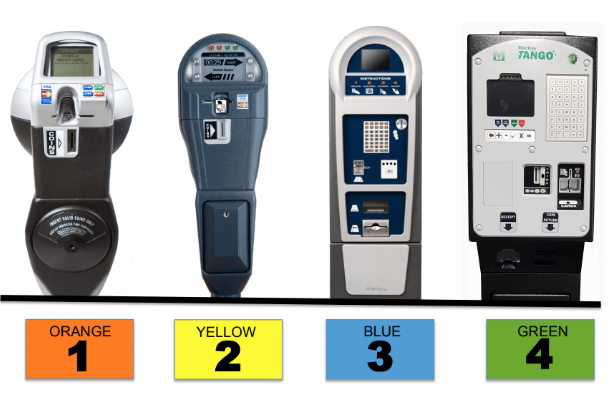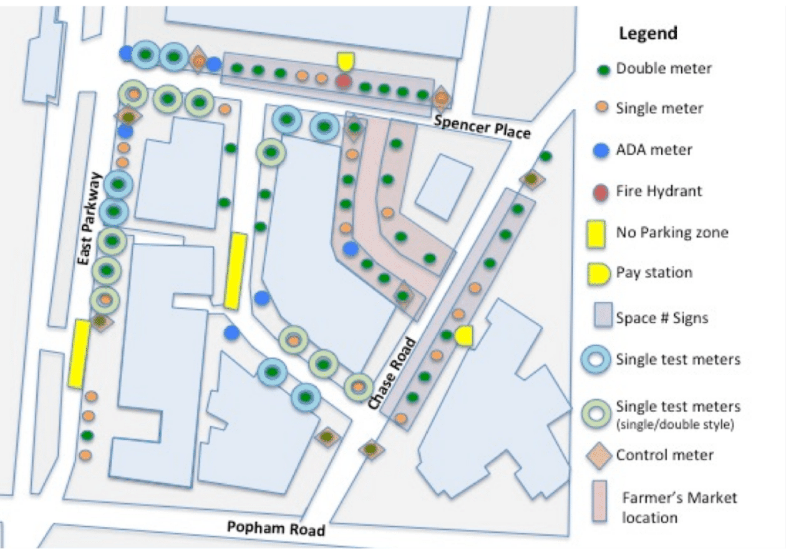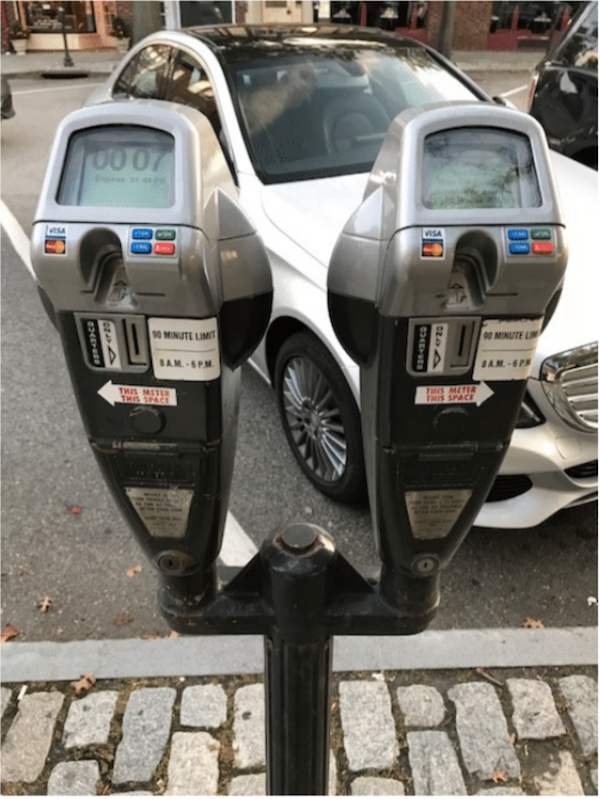Smart Parking Meter Test Results In, Village to Evaluate Mobile Parking App
- Thursday, 24 May 2018 11:19
- Last Updated: Thursday, 24 May 2018 20:29
- Published: Thursday, 24 May 2018 11:19
- Hits: 5418
You may soon be able to use a state of the art parking app to feed the parking meter, making the need for a roll quarters a thing of the past. The Village recently completed a test of four different types of meters, but ultimately decided that these new meters did not warrant the expense.
Throughout fall of 2017 and winter of 2018, you may have noticed some new parking meters in the village center of Scarsdale. Specifically, four different types of meters were set up: two single/double meters, and two multi space meters.

Option 1 (Orange) was a single space smart meter that could take coins or credits made by IPS.
Option 2 (Yellow) was made by POM and optimized so that some of its meters could handle two spots in a single meter, and users would press a button to indicate which spot they parked in.
Option 3 (Blue) was a multispace paystation made by T2.
Option 4 (Green) was a multispace paystation made by MacKay.
16 traditional parking meters were established as a control group against which to gauge a baseline revenue expectation for the new test meters. These 16 control meters’ revenue was compared to revenue from 16 parking spots of each test meter. The control meters had an approximate monthly revenue of $3,000. Option 1 earned the most revenue with an average of $3286.19 a month, while option 2 earned less revenue at an average of $2902.25 a month likely due to reported user confusion for the double meters. Option 3 scored third in revenue at an average of $2821.95 a month but experienced some downtime in revenue collection due to a battery configuration issue. Option 4 scored last in revenue at an average of $2132.16 a month but also experienced operational downtime due to a service issue.
 Placement of the Test Meters in the Village CenterA survey was established to gather community input on the different meters, and asked users questions relating to ease of use, functionality, and aesthetics. Of the 304 accepted responses, the vast majority responded favorably to option 1. Possible opposition to option 2 came from the difficulty in using the double meters. Options three and four were the two multi space meter options, and were among the least popular likely due to having to wait on a line, being forced to use the pay station in the rain/snow without a shelter, and/or various operational issues, including credit card payment issues, broken pay stations, and confusing instructions. The single and double meters, however, also faced some operational issues including broken meters and coin blockages. Among the most common comments on the survey were “broken”, “unattractive”, “No pay stations”, “inconvenient”, “overpayment”, and “confusing”. It should also be noted, however, that due to the nature of this survey, a strong voluntary response bias may have occurred where only patrons who were dissatisfied with their parking experience responded, and the responses may not reflect the views of the majority of Scarsdalians.
Placement of the Test Meters in the Village CenterA survey was established to gather community input on the different meters, and asked users questions relating to ease of use, functionality, and aesthetics. Of the 304 accepted responses, the vast majority responded favorably to option 1. Possible opposition to option 2 came from the difficulty in using the double meters. Options three and four were the two multi space meter options, and were among the least popular likely due to having to wait on a line, being forced to use the pay station in the rain/snow without a shelter, and/or various operational issues, including credit card payment issues, broken pay stations, and confusing instructions. The single and double meters, however, also faced some operational issues including broken meters and coin blockages. Among the most common comments on the survey were “broken”, “unattractive”, “No pay stations”, “inconvenient”, “overpayment”, and “confusing”. It should also be noted, however, that due to the nature of this survey, a strong voluntary response bias may have occurred where only patrons who were dissatisfied with their parking experience responded, and the responses may not reflect the views of the majority of Scarsdalians.
One of the key features of the new meters was the ability to use a credit card. A $1 minimum parking fee was established due to the number of fees associated with using a credit card, including the statement and gateway fees. This resulted in many credit card users being forced to overpay for their parking. These credit card processing fees would cost the village an additional $40,500-$89,100 a year depending on the average blended transaction fee. The Most Popular Meter Rated In The Survey
The Most Popular Meter Rated In The Survey
Another consideration of the study involved the potential implementation of a mobile app for either the new or existing meters. 33% of survey respondents reported already having a parking app on their phone. Parking app users would be able to pay for their parking on the phone, allowing them to avoid refilling their meter in the harsh weather outside. The app can be implemented with or without smart meters, however, the violation flag will not change on a non-smart meter even if a user paid via the app. Police officers will be able to see who paid electronically via an app if smart meters are not introduced, and proof of payment is usually provided in the app in case of an enforcement error. However this could cause a lot of confusion among user who pay but still see a violation notice on the meter when they return to their car.
Additionally, the village will have the freedom to decide whether the user or the village will pick up the credit card transaction fees when implemented. Generally speaking, however, most communities cover the transaction fees, while the user picks up a convenience fee that is paid to the app (usually ranging from $0.20 to $0.35). In a neighboring Westchester community, parking app usage is on the upswing, with 5% of all parking purchases made via an app in December 2016 and 16% of purchases made via an app by February 2018.
The board has decided at this time not move forward with the implementation of a new smart meter or paystation due to the various issues voiced by community members and cost of purchasing the new meters. The board, however, also decided to pursue an app to provide options to people who park in Scarsdale without implementing a smart meter or paystation. The village will soon begin to investigate different parking apps so Scarsdale residents can have the best possible parking experience moving forward.